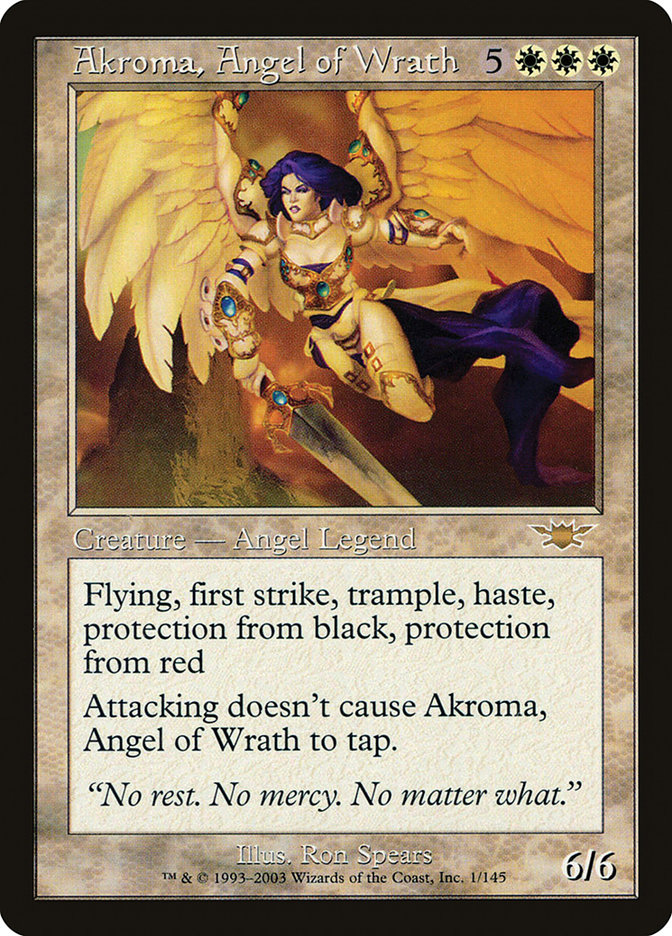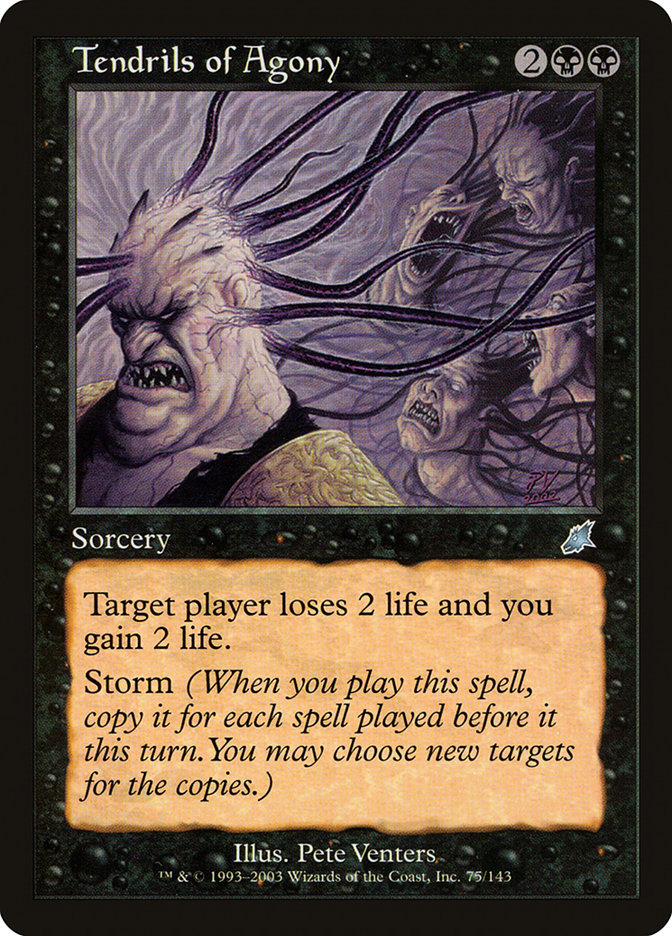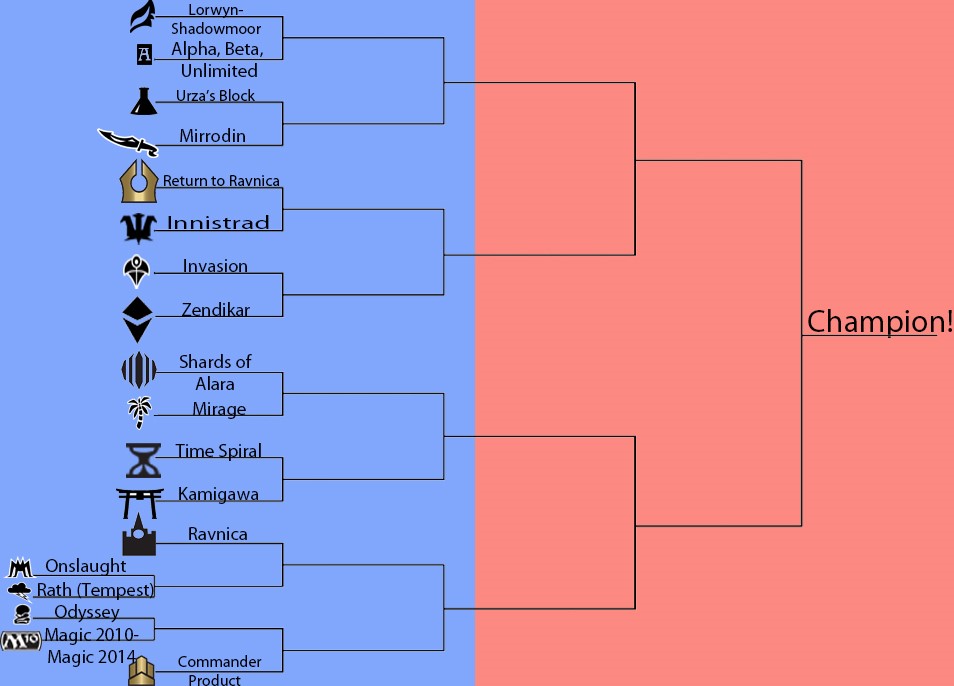This article series pits two blocks throughout Magic: the Gathering’s history against each other each week in order to find out which one contributed the most to Commander and deserves to soldier on towards claiming the grand title. Today, the innovative Tempest Block fights tooth and claw against the creature-heavy Onslaught Block’s tribal synergy, with each trying to advance up the bracket and win the Battle of the Blocks. Onslaught Block is a creature-focused trio of sets that excited Magic players when it first arrived due to its focus on the beloved tribes of Magic. With hits like Catapult Master and the Warchief cycle, Onslaught Block played to what Magic players wanted: creatures working together on the same team! Onslaught also brought the first all-creature set to the planes of Magic: the Gathering in Legions, which also returned the crowd-favorite Slivers. Onslaught Block brought both hits and misses in its block-specific mechanics. The creature-focused Provoke and Tribal-focused Amplify mechanics both fell flat beyond Limited due to their very narrow applications. On the other side of the Mirari, Onslaught Block brought the super-cool Morph mechanic and the Legacy powerhouse Storm mechanic, both of which are still frequently played in Commander.
Aged like a fine wine, Tempest Block is the follow-up to the first block in the Silver Age of Magic, Mirage Block. A set focused on both Limited and Standard, it followed the Weatherlight crew as they traveled to rescue Captain Sisay from the clutches of Volrath, Evincar of the dark plane of Rath. An interesting aspect of this block was the introduction of the Shadow mechanic. Shadow conceptualized the idea of a world between worlds where creatures could pass by unseen while still dealing damage to planeswalkers. Sadly, few shadow creatures find their ways to the Commander table unless they provide some sort of utility like Soltari Champion or Nether Traitor. Buyback is the other mechanic introduced in Tempest Block and is used to full effect on cards like Capsize or Fanning the Flames. Overall, Tempest Block showcased what Wizards of the Coast could accomplish by having a distinct vision for the future and is a good representation of the quality of early Magic sets.
In order to set the scene for this battle, the current bracket is displayed below.
The winner of this battle goes on to duke it out with the fan-favorite Ravnica Block in a duel for the Elite Eight! Remember, these battles are to decide which block contributed the most to Commander, not the best block in all of Magic: the Gathering. They will be compared in five different categories. The Staples that each block brought to the format is our first category, which is followed by the Commander category that speaks to the legendary creatures that are the lifeblood of this amazing format. The Strategies category judges the approaches that were bolstered by the blocks, while the Flavor category is where the oft-played but fun cards get a chance to shine. Finally, The Bad is where the blocks can lose points for bringing unsavory things to Commander.
Staples
Instead of the usual format for the staples section, I’m going to put the top five first and follow that up with a paragraph describing how the sets’ staples fit in Commander.
Five Noteworthy Staples from Onslaught Block
Onslaught Block was very kind to Commander by bringing the most important thing for deckbuilding: mana fixing! Fixing is paramount in Commander and Onslaught Block came packaged with fetchlands, Explosive Vegetation, Krosan Tusker and Eternal Dragon. These cards help decks run smoother and play the other cards in your Commander deck. Most of the Muse cycle has seen varying amounts of play in Commander but Seedborn Muse is the kill-on-sight creature from Onslaught Block. It has become ubiquitous in Simic and Junk decks like Ghave, Guru of Spores or Vorel of the Hull Clade due to its amazing untapping ability. Graveborn Muse also sees work in black decks that want another Phyrexian Arena effect or as an auto-include in Zombie decks. The game-warping effects of Decree of Pain and Decree of Justice makes them the two most commonly-played big mana sorceries you could want to harness, giving players something amazing to do with their built-up mana.
Five Noteworthy Staples from Tempest Blocks
Grave Pact is one of the most-played cards in Commander, sitting right behind staples like Cultivate and basic Island. This heavily-abusable effect came from the shadowy plane of Rath and has been used to wrath the opponent’s board for the last fourteen years! Grave Pact has seen its ability spliced onto cards like Butcher of Malakir or Savra, Queen of the Golgari, and each version sees play in Commander. Coat of Arms is the artifact that breathes life into the casually competitive tribal Commander decks, allowing them to enter the fray against the less-linear decks in the format. Both Evacuation and Propaganda have found slots in the more controlling side of Commander, while Living Death is a game-ending card in the right deck. Survival of the Fittest is the second-greatest green enchantment printed for Commander, coming in behind only Greater Good.
Looking through both blocks, each one has brought great things to the Commander format but Tempest Block’s Grave Pact and Living Death edges out Onslaught Block’s Seedborn Muse and friends due to the Primeval Titan effect. If people will run black just for access to these two, that’s a clear sign right there.
Commanders
 Akroma, Angel of Wrath. That name represented Magic for five years until the eventual repositioning of planeswalkers to the forefront of Magic branding. Akroma was so important to Magic players that she was not only reprinted in Time Spiral, but had another version of her printed in Planar Chaos as Akroma, Angel of Fury and was then immortalized in Future Sight with Akroma’s Memorial. In Commander, Akroma, Angel of Wrath still sees some play as a monowhite commander in angel-themed decks, but has fallen out of favor for the HGH-infused Avacyn, Angel of Hope or downright-mean Iona, Shield of Emeria.
Akroma, Angel of Wrath. That name represented Magic for five years until the eventual repositioning of planeswalkers to the forefront of Magic branding. Akroma was so important to Magic players that she was not only reprinted in Time Spiral, but had another version of her printed in Planar Chaos as Akroma, Angel of Fury and was then immortalized in Future Sight with Akroma’s Memorial. In Commander, Akroma, Angel of Wrath still sees some play as a monowhite commander in angel-themed decks, but has fallen out of favor for the HGH-infused Avacyn, Angel of Hope or downright-mean Iona, Shield of Emeria.
The Pitfighter legends from Onslaught are a cool five card cycle of interesting legendary creatures, with the most popular of them being Arcanis the Omnipotent. Although they see some sporadic play, only Arcanis the Omnipotent is consistently played as a commander. The real spicy commanders in Onslaught Block are the two five-color legends – Sliver Overlord and Karona, False God. Karona has become the official savior of off-kilter tribes since the inception of Commander, allowing decks like five color allies and even Zuberas to have an impactful tribal Commander. Sliver Overlord is the most common Sliver general due to its toolbox or combo applications. Sliver Overlord goes above and beyond the call of duty for the sliver deck by searching for the answer to any on board situation. Low on life? There’s an Essence Sliver for that. Blockers in the way? Why not get past them with Shifting Sliver?
Tempest Block brings some meager additions to the Commander landscape with Vhati il-Dal and Sliver Queen being the only commanders played with any sort of frequency. While beloved by many for nostalgia reasons, Sliver Queen has been mostly phased out by Sliver Overlord due to its high-octane ability. Instead of solving each problem that appears like Sliver Overlord, Sliver Queen can only flood the board with tokens and hope to kill the opponents through the red zone. In Commander, that ability falls flat to the utility that Sliver Overlord brings to the table, leaving on a small amount of play for the Sliver Queen at the helm of sliver Commander decks. Vhati il-Dal is a mildly-popular commander that utilizes his ability to control the board and eventually win with large Golgari creatures, rounding out a pretty disappointing turnout from Tempest Block.
Onslaught Block has one of the most iconic creatures in Magic as well as the de-facto Sliver Commander. It wins this category handily.
Strategies
While writing these articles, one of the things I’ve noticed is that some sets are rather similar. Tempest Block first introduced the Sliver creature type, a set of hivemind creatures where each one shares its abilities to the neighboring slivers. Onslaught then brought back Slivers in its tribal-centric sets due to Slivers being a tribe of lords that connects with the casual player. Each of these sets contributed equally to the same strategy, so it’s a wash in the Sliver category for both of these blocks. Another similarity between these two is that each block’s main mechanic, morph for Onslaught and shadow for Tempest, have birthed new strategies for Commander. I’ve seen five-color morph decks and Mirko Vosk shadow decks played to great effect with their quirkiness making the entire table happy to see them in action.
Tempest Block’s Goblin Bombardment, Altar of Dementia, and Grave Pact are format all-stars for sacrifice-based decks in Commander, allowing those powerful strategies to perform at a breakneck speed. Hermit Druid is another Tempest Block card that was almost on the banned list for its use in a variety of combo decks but has now settled down as a powerhouse in graveyard-based dredge decks alongside the Tempest sorcery Living Death. Turbo-Fog decks like Angus Mackenzie have Stronghold to thank for the infuriating Constant Mists, and Elf tribal decks can turn to Eladamri, Lord of Leaves for some much-needed protection from spot removal. Blink strategies find some key cards in Erratic Portal and Equilibrium in this block, while our oft-talked about painful wheel decks have Tempest Block to thank for the first printing of Megrim. Exodus also brings us Survival of the Fittest, one of the greatest toolbox enablers of all time and an amazing tutor machine or dredge enabler.
Onslaught Block takes a hammer to this category by bringing the tribal favorite warchief cycle to a Beast, Goblin, Soldier, Illusion or Zombie deck near you. Tribal is further helped with Patriarch’s Bidding and cards like Catapult Master seeing print in this set. Sacrifice-based decks also get cards in Onslaught Block with Carrion Feeder, and we also see the printing of Enchantress’s Presence for enchantment-heavy decks. As we tread off the beaten path in Commander we find that Aven Brigadier is a rare lord for the bird decks, Astral Slide sees some play in cycling-focused decks and Willbender forces everyone to treat each morph creature with respect. Mill decks also praise Onslaught Block for Dreamborn Muse, one of the only ways to consistently mill out a table.
With cards like Goblin Bombardment, Living Death and Megrim among its ranks, Tempest Block has the strategy enablers to steal this category from the heavy favorite, Onslaught Block.
Flavor
Tempest Block is the first full block chronicling the actions of Gerrard and the crew of the Weatherlight as they go to rescue Captain Sisay from Volrath. Some very flavorful cards exist in this set, like Volrath’s Stronghold constantly returning lost souls into the nether of the library or Survival of the Fittest showcasing a goblin with a blood-red smile hunched over a recently-slain kinsman. Yet most of the cards suffer from the same problem flavor-wise as the rest of the cards during the Weatherlight saga: they require either previous knowledge of the storyline or more than one card to fully understand the flavor of a card. Ask a new player who Gerrard is quiz them about the coolness of Squee’s Toy and they’ll give you a befuddled turn of the head.
Onslaught Block brings the flavor in some explosive ways. The rules-text-covered Day of the Dragons turns all the creatures into Dragons, Form of the Dragon turns you into a Dragon, and cards like Siege-Gang Commander not only help their tribal archetype but add a little bit of fun to the set. There is a Doom Cannon in this set! We have to give massive credit for the one and only card that can turn the player into a full-fledged dragon, that is a special flavor of cool.
Being a Dragon is fun. Onslaught takes this with the flaming fury of a dragon scorned.
The Bad
 There is a distinct reason we haven’t talked about Storm yet, although the format has autocorrected to trend away from a dominant Storm deck decks like the turn-four win in Maralen of the Mornsong with Ad Nauseum and Tendrils of Agony showcase the harm the mechanic brings to Commander. Trade Secrets is banned in Commander due to how often it turns Commander games into a two-person game, and Biorhythm is one of the original banned cards in Commander. Not to mention the automatic-win button that is Insurrection that comes down as an eight-mana victory card that feels like it defeats the entire purpose of deck design. Plus, Decree of Annihilation destroys the entire board and locks the game into a topdecking war that leads to everyone staring daggers at the player who cast it.
There is a distinct reason we haven’t talked about Storm yet, although the format has autocorrected to trend away from a dominant Storm deck decks like the turn-four win in Maralen of the Mornsong with Ad Nauseum and Tendrils of Agony showcase the harm the mechanic brings to Commander. Trade Secrets is banned in Commander due to how often it turns Commander games into a two-person game, and Biorhythm is one of the original banned cards in Commander. Not to mention the automatic-win button that is Insurrection that comes down as an eight-mana victory card that feels like it defeats the entire purpose of deck design. Plus, Decree of Annihilation destroys the entire board and locks the game into a topdecking war that leads to everyone staring daggers at the player who cast it.
Tempest Block also has some skeletons in the closet with the banned black enchantment Recurring Nightmare and the always-unfun Capsize showcasing the darker side of the buyback mechanic. Mind over Matter and Intruder Alarm are two cards that enable multiple combo finishes akin to the Tendrils of Agony kills from Onslaught Block. The only difference is that instead of working up to it with other cards, the correct commander leads to a single-card combo much like the maligned Niv-Mizzet, the Firemind + Curiosity combo. Earthcraft being the final piece of badness from Tempest Block is not due to it enabling Squirrel’s Nest shenanigans but because it is an absolutely broken card in any token based deck, looking at you Ghave, Guru of Spores.
Each block has brought some bad cards to Commander, but Tempest Block’s unfun combo enablers allows Tempest to win at losing our love in this category.
Looking at these two blocks side by side, the amazing cards added by Tempest Block just overpower the tribal offerings of Onslaught Block. Although everyone likes suiting up a Goblin deck for a romp in the Commander ring, cards like Survival of the Fittest and Grave Pact are more important for the current state of Commander. Tempest Block wins this round of Battle of the Block, advancing on to face the fan-favorite Ravnica block!
Next week is one of my favorite matchups, the Pit-fighting Odyssey Block versus the groundbreaking Magic 2010-2014 sets! If you think I got it wrong or have any comments or criticisms on this article, feel free to voice them in the comments! I think this one was very close, so if you think Onlsaught brought more to the Commander format let me know why below.

